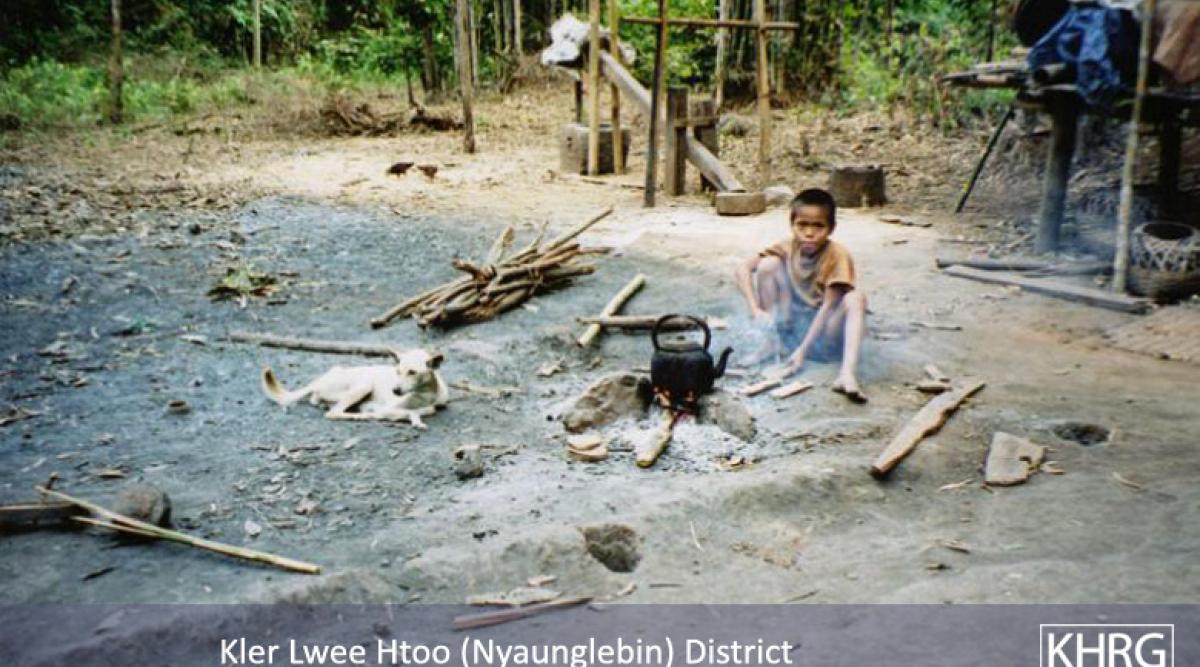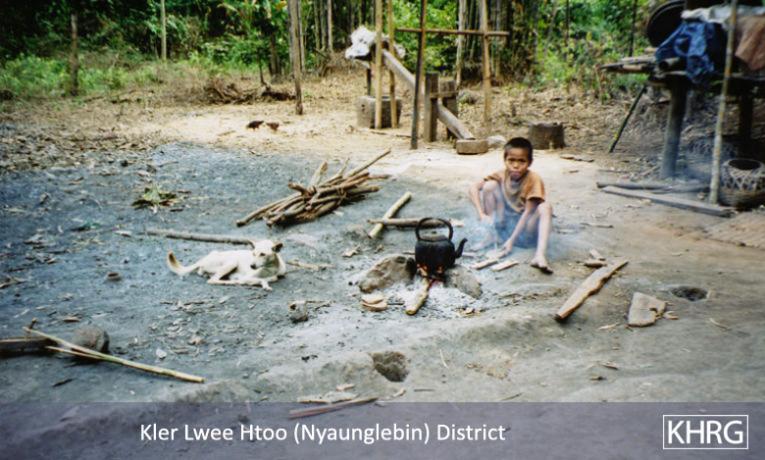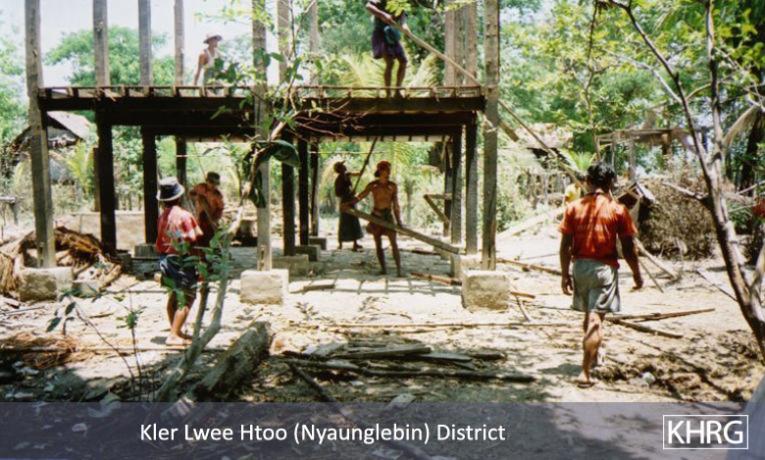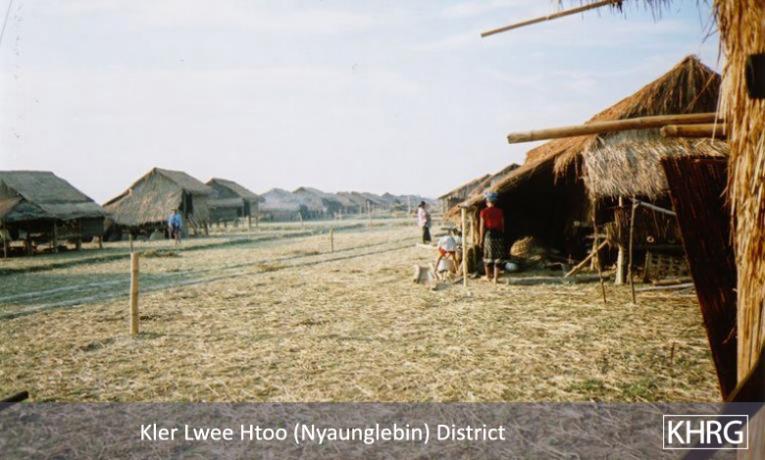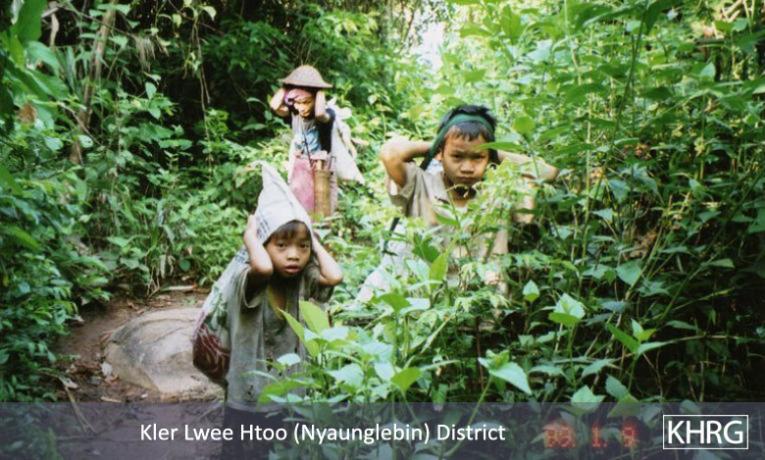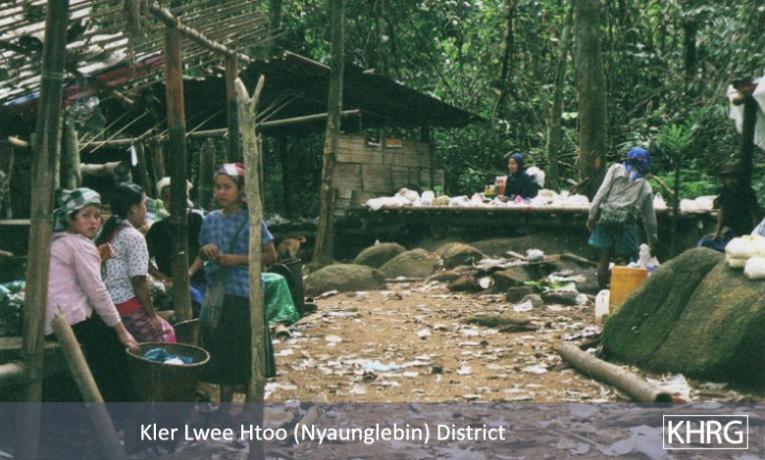This report presents information on ongoing abuses in Nyaunglebin (Kler Lweh Htoo) District, Karen State committed by SPDC forces during the period of March to May 2006. Attacks on hill villagers have continued as SPDC units seek to depopulate the hills and force all villagers to relocate to military-controlled villages in the plains and along roadways. However, those villagers living in SPDC-controlled areas are subject as well to continued abuses including arbitrary arrest and detention, extortion, restricted movement and forced labour.
Villagers living in Nyaunglebin District (Kler Lweh Htoo in Karen) have for years faced direct harassment at the hands of the State Peace and Development Council (SPDC). Despite a decreasing engagement between SPDC forces and the Karen National Liberation Army (KNLA), rapid militarisation of the region continues. Since November 2005, the SPDC has sustained a military offensive focused on the rural areas of northern Karen State. The pattern and location of attacks in Nyaunglebin District described in this report link them with the broader SPDC offensive throughout northern Karen State. This campaign has been directed not against insurgent forces, but rather Karen villagers living in rural areas outside of complete SPDC control. Widespread and systematic abuses have been central to this campaign as the SPDC seeks to relocate the Karen population living in the hills to military-controlled villages along motor roads and in the plains of western Karen State. These abuses include forced relocation, destruction of homes, confiscation of food and livestock and arbitrary execution. Those who do relocate to SPDC-controlled sites face more regular abuses by military units such as arbitrary arrest and detention, extortion, restricted movement and forced labour alongside food and water scarcity and absent prospects of a sustainable livelihood.
SPDC military operations in Nyaunglebin
In the current SPDC offensive in Nyaunglebin District, the military has perpetrated attacks against villagers in the hills of Mone, Kyauk Kyi, and Shwegyin Townships (Mu, Ler Doh and Hsaw Tee in Karen; see map). Some of the SPDC units deployed in Nyaunglebin District and identified by KHRG are Military Operations Command [1] (MOC) #10, 16 and 21 which control Light Infantry Battalions [2] (LIB) #223, 230, 233, 240, 241, 276, 351, 362, 364, 366, 368, 389, 439, 590, 599, 601, 801, 802 and Infantry Battalions (IB) #56, 68, 69 and 237. LIB #562, 567 and IB #440 under the control of MOC #16 which were formerly based in Nyaunglebin District, have been redeployed for military operations in Papun District (Mutraw in Karen) to the east of Nyaunglebin. In the last week of June, LIB #536, LIB #352 and one other battalion from MOC #15 also attacked villages in eastern Mone township as they passed through on their way from Papun district to Toungoo district.
In Shwegyin Township the current SPDC units deployed include LIB #223, 230, 241, 276, 389, 601, 802 and IB #237 of MOC #16. The second column commander of LIB #241 was replaced in March. One of the companies from LIB #241 constructed a new camp at Ko Sghaw and took control of security in the area. The first column commander of LIB #241 was stationed at Koh Peh along with one company. A second company from LIB #241 was stationed at Htee Pay Doh. Command of LIB #241 was given over to Southern Command headquarters (Toungoo) on April 3rd. Columns 1 and 2 of IB #56 and columns 1 and 2 of LIB #233 and 801 were also camped at Koh Peh and Ko Sghaw. Troop columns from LIB #276 were camped at Kyaw Pya, Way K' Loe, Ko Peh and Htee Pa Doh and were engaged in operations around the Shwegyin River. MOC #21 was based at Wa Koh Law Der and operating around the Tee Blah area.
SPDC Troops from LIB #387, 611 and 320 under the control of MOC #21 and Strategic Operations Command #2 began construction of a new camp on Ro Sah Hill at Boe Wah, Kyauk Kyi Township primarily as a food storage facility. By May 12th troops had begun storing food at the site. Supplies are to come from Saw Bweh Der camp and then be sent onwards to support troops at Maw Law and Kaw Tha Say.
Forced relocation
SDPC troops continued to forcibly relocate villagers from the hills and the plains to areas more completely under military control, such as near army camps or roadways. SPDC units operating in the plains areas of western Nyaunglebin District have been ordering rice field workers to destroy their huts throughout the rice fields so as to expose paddy stores to the rain. Destruction of food stores is a complementary abuse to forced relocation as it removes villagers' capacity to sustain themselves at their old villages.
In Mone Township forced relocation of Karen civilians from the hills continued unabated. On April 8th, SPDC troops from LIB #562 and #567 and IB #440 under the control of MOC #16 entered Yu Loh and Ka Mu Loh villages in southern Tantabin Township, Toungoo District just north of Mone Township. The troops forced the inhabitants of both villages to relocate to Play Hsa Loh village, Mone Township. The livelihood of the villagers, who were dependent on their betel nut and durian plantations, was undermined by the relocation. On April 4th 2006, SPDC troops from LIB #590, based in Myaung Oo and under the control of Camp Commander Thaw Htay, ordered Paw Hi Der villagers to move to SPDC-controlled relocation sites. The troops told the villagers that if they did not want to relocate, they would have to pay 1,500,000 Kyat. The villagers collected the money amongst themselves and paid Camp Commander Thaw Htay on April 16th. On April 25th, SPDC troops from LIB #44 entered Taw Awk Pay Der Daw, Mone Township and burnt down Saw Say Mu's barn containing 70 baskets of paddy. The troops then smashed the roofs of barns belonging to Saw Pler Mu and Naw Eh Ro. Ensuing rain soaked and damaged the paddy stored within the barns.
On April 4th 2006, SPDC LIB #439 Deputy Commander Zaw Htun ordered villagers from Pa T'Lah, Noh Ghaw and Weh Ka Daw village tracts – including Pa T'Lah, Hi Po Der, Taw Ko, P'Taw Aw, Htay Paw, Dah K'Lah, Weh Lah Dtaw and other villages - to relocate to Plaw Law Bler (Ywa Tha Yaw), Kyauk Kyi Township which is located in flat ricefields between Dtet Tu and Thu K'Bee villages. SPDC forces ordered all villagers to destroy their homes prior to relocating. They were given seven days in which to relocate and told that if they had not left within this time, SPDC troops would burn down the village. As most of the villagers were poor, they did not own carts with which to carry their possessions to the relocation site. They therefore had to carry furniture and other household items to the new site by foot.
"The Burmese soldiers forced us to relocate our village to Law Maw. They gave orders to us starting in March. They said we must smash our own houses. At first our villagers paid money to the soldiers so that we would not have to relocate our village, and we could still stay in our village for many days. But eventually the Operations Commander came and he said we villagers must relocate. He gave us three days to move, and said if we did not move within three days they would 'clear all'. If they saw people they would shoot us, and if they found any houses they would burn them. On April 28th, the deadline for us, they said they did not want to see any of us in our village. They forced us to relocate between Dtet Tu and Thu K'Bee villages in the plains and to enclose our homes with a fence. We didn't want to relocate there. They said we must destroy our houses. They said if our village did not obey the orders, they would burn down our homes."
– Naw M--- (female, 39), T--- village, Pa Ta Na village tract, Kyauk Kyi Township (April 2006)
At Plaw Law Bler relocation site, the military allowed each family a square plot of only ten armspans (15 m / 50 feet) per side on which to construct their new homes, with no space allotted for gardens or livestock. No building materials are provided; villagers were expected to bring their own by stripping their houses in the village, but those without carts for transport could not bring these and have had to build their new houses from grass and rice straw. If the newly constructed house did not meet SPDC specifications, soldiers beat the villagers and ordered them to destroy the building and begin again. Villagers were ordered to construct a fence around the entire relocation site as well as around each individual property. Some villagers with large families stated that the space provided was not large enough for them and those who reared domestic animals were unable to keep them as no other land was provided. Livestock that the villagers did keep was under constant threat of theft from local civilian thieves and SPDC soldiers. Villagers were unable to keep livestock at their old villages as the SPDC threatened that if they left the relocation site without permission they would be accused of having connections with the Karen National Union (KNU).
"If we want to return to our old village we must get a document from them [SPDC] and we can return only during the daytime. They said that if they saw us in the night time they would shoot us. The place to which we have relocated now is a two-hour walk from our old village… We are faced with problems at the relocation site now. It is very hot in the day time because there are no trees or shade there. A few days ago the rain fell and everywhere became wet and muddy. We heard the SPDC soldiers would be collecting a tax of 1,000 Kyat from every household each month. In our section we have five villages: Pa T'Lah, Taw Ko, Khaw, Thaw Hi Po Der, and Htee Baw Naw. Many children are feeling ill, and last night [April 22nd 2006] a person died. His name was U Mya Thaw, 60 years old."
– Naw M---- (female, 39), T--- village, Pa Ta Na village tract, Kyauk Kyi Township (April 2006)
No food or medical assistance is provided at the site; villagers have to survive on what food they brought with them along with whatever they can forage or earn through day labour in the surrounding area. A further problem at Plaw Law Bler relocation site has been the scarcity of water. Attempts to dig a well failed and villagers have to retrieve water from a neighbouring village, a half-hour away by foot. Some of the villagers wanted to return to their old village in order to take a bath but SPDC troops forbade them. The lack of water has compounded the problem of food scarcity at the relocation site. As most villagers had no carts to transport possessions from their old village, they were only able to bring as much rice as they could carry.
Forced labour
At Plaw Law Bler relocation site both men and women villagers have been forced to work clearing land and digging holes for the construction of a new military base. Some villagers interviewed in late April said they had already been given orders that each person must clear at least 30 square yards of ground for the military camp. This forced labour, called loh ah pay by the SPDC, cuts into the villagers' own work time and hinders their capacity to maintain an adequate livelihood, but it is a regular practice in areas under military control.
Other areas in the district where this practice is prevalent include northern Mone Township. On April 13th, for example, 150 SPDC troops ordered the inhabitants of Ma La Daw village to cut down all trees and vegetation from Wai Mi Hill and Wee Lee Hill, as this was to be the site of a new military camp. Beginning in May, SPDC troops from LIB #366, 377 and 399 under the control of LID #55 [3] began sending rations to the military camp at Ma La Daw. The troops forced villagers from Ma Law Daw, T' Kaw Pwa, Myaung Oo and Chu T' Lo to carry the supplies to the camp by foot or bullock cart. Those living in these villages under SPDC control have been forced to labour for the military units based at Ma La Daw village and Gawlawah Lu (Kyet Taung Mway) on a regular basis. Other incidents of loh ah pay during this period include the use of villagers to carry items such as rice and bullets along the Shwegyin - Kyauk Kyi vehicle road across the plains south of Mone Township.
Restriction of movement
As a further means of undermining civilian networks in the hills, SPDC forces have restricted the movement of villagers between villages. This practice has a severe impact on villagers' capacity to sustain an adequate livelihood as agriculture and trade networks are severed. A KHRG field researcher found that about 800 civilians from Mone Township who had fled the SPDC in order to reside in the forest were without access to food supplies due to SPDC restrictions on movement and blockades of trading routes. The KNU was therefore providing rice to the displaced villagers.
On May 9th, MOC #16 Colonel Soe Oo ordered villagers from Maw Keh Tha Per Koh, Baw Bpee Der, Aung Chan Tha, Myaung Oo, Meh S'Lee Gone, Pa Doh Kyaw Hta, Kyaw Kyi Paw and K'Muh Loh in northern Mone Township, and Yu Loh and Tha Pyay Nyunt in southern Tantabin District, Toungoo Township not to leave their villages. The soldiers said that if they saw anyone outside of their villages they would kill them. If the villagers needed to buy rice, they would have to purchase it from the military at an inflated price of 10,000 Kyat per basket. [4]
Arbitrary arrest, detention and extortion
SPDC troops regularly arrested and detained villagers living in the military-controlled plains of western Nyaunglebin district on arbitrary grounds typically for the purpose of extorting funds or upon suspicion that the villagers have links with the KNU. In one incident at Mwey Kwin ferry terminal in the plains of western Mone Township Sergeant Htun Myint of LIB #599 arrested Saw Baw Htoo of Way Sweh village. SPDC troops took him to their camp at Myaung Oo where Captain Khing Maung Myint demanded 500,000 Kyat for his release.
On April 28th, Warrant Officer Than Htay and sergeant Yeh Min went to arrest villagers from Way Sweh, Gko Nee and Noh Nya Lah villages in Mone Township pursuant to orders issued by LIB #599 Battalion Commander Yan Naing to all Kyun Bin Seik camp officers. The following villagers were arrested: Nay Lay and Sho L'Moh of Way Sweh village; Saw Maung Htay, Naw Kri Heh and Nay Ger Htoo of Gko Nee village; Naw T'Kaw Paw, Saw Bpin Tun Pa and Blaw Wah of Nga Pway Taw village; and Saw Pway Moo of Noh Nya Lah village. Subsequent to the arrests, SPDC soldiers severely tortured the detained villagers. On April 30th, the soldiers demanded 2,500,000 Kyat ransom for the villagers and released them upon payment. However one villager, Maung Htay, was not released but sent instead to Kyaw Pya army camp.
In a separate incident in Kyauk Kyi Township SPDC LIB #60 Battalion Commander Maung Thein Soe accused Naw Gay Paw of having KNU connections. He then arrested her and put her in Kyauk Kyi jail for two months. She was later sent to Toungoo prison. On her arrival at the prison, Burmese police demanded 2,000 Kyat from her. She had to pay 500 Kyat to use the toilet, 200 Kyat to take a bath and 500 Kyat to get her meals. In the prison, the police regularly reprimanded and tortured her. Although she became sick while incarcerated, prison officials would not allow her to transfer to the hospital until she was severely ill. When she was eventually allowed to stay in the hospital her legs were kept in shackles.
SPDC soldiers have been collecting taxes on Th'Yeh Chaung Bridge in Kyauk Kyi Township amounting to about 1,000 Kyat per car, 100 Kyat per motorcycle and 200 Kyat per bullock cart. On April 19th, troops from SPDC IB #57 operating in Kyauk Kyi Township ordered all sawmill and tractor owners to pay 50,000 Kyat within one month for a school fund, 30,000 Kyat and ¼ ton of wood for the house of IB #57 Commander Min Kyaing Thant and 20,000 Kyat for Regional Commander Tint Sway.
Killing
During the period of this report, SPDC forces conducted extensive attacks against villagers in the hill regions of Mone Township. Villagers in this region were specifically targeted, shot and killed. These attacks have come in conjunction with systematic attempts to forcibly relocate villagers to SPDC-controlled roadsides or the plains areas in the western parts of the township.
On March 13th, SPDC troops from LIB #364, #366 and #368 shot and killed Saw Oh Moo (male, 19), of Saw Mi Lu village, Mone Township. They subsequently burnt down a barn containing 100 baskets of paddy belonging to Saw Pah Reh and burnt down six houses and their contents in T'Gaw Pu village. On March 27th at 2:00 pm LIB #240, #522 and #567, under the control of MOC #16, attacked Htee Day Kee Village in Kyaw Pya village tract, Mone Township. In the attack, SPDC soldiers killed two villagers (Maung Saw Cha, male, 35 and Naw Wee Bu, female, 75) and wounded a 10-year-old girl. On March 9th, troops from LIB #366, 377 and 399 under the control of LID #55 began operations around their base camp at Ma La Daw village, Mone Township. Troops from these units arrested Maung Than Lwin (male, 28), a villager from Nya Mu Kee, and killed him at Theh K'Per Lu. In the area around Ma La Daw they killed a villager named Poe Hser Pya and in K'Pa Hta they killed an unnamed mother and daughter.
Including the victims listed above, KHRG has identified 19 villagers who were shot and killed by SPDC forces in Mone Township from February to April. The victims' name, sex, age, and village as well as the date of killing and responsible military personnel or units are as follows:
# Name Sex Age Village Date Responsible Personnel 1 Saw K' Waw Htoo male 42 Kho Pu February 15th LID #33 & 599 2 Saw Du Kaw male 53 Kheh Ker Koh March 8th LIB #364, 366 & 368 3 Saw Eh Lah Hser male 12 Kheh Ker Koh March 8th LIB #364, 366 & 368 4 Maung Thein Kya male 28 Klaw Kee March 9th MOC #10 & LIB #364 5 Maung Than Lwin male 28 Nya Mu Kee March 9th LIB #366, 377 and 399 6 Poe Hser Pya male ? Ma La Daw March 9th LIB #366, 377 and 399 7 Saw Oh Moo male 19 Saw Mi Lu March 13th LIB #364, 366 & 368 8 Naw Beh Bay Paw female 18 Ler Klah Hta Gaw Pu March 13th LIB #599 9 Saw Maung Cha male 35 Kyaw Pya March 27th MOC #16, LIB #562 & 567 10 Naw Wee Bu female 75 Kyaw Pya March 27th IB #440 11 Saw Tun Yin male 47 Ma La Daw April 7th IB #440 12 Saw Taw Toe Roh male 24 Ma La Daw April 7th IB #440 13 Saw April Moo male 18 Law Lar Daw April 7th IB #440 14 Saw Ler Pweh Say male 20 Ler Klah April 7th MOC #16 15 Saw Maung Htay male ? ? April 28th LIB #599 16 Saw Na Doh male 45 Theh Baw Der ? Soe Oo District Commander 17 Saw Maung Khaw male 24 Theh Baw Der ? Thein Ni Myo Camp Commander, LIB #503 & 567 18 Maung Thaw Lwin male 30 ? ? ? 19 Saw Aung Htun male 35 ? ? ?
Destruction and Looting of property
During the period of this report SPDC military units in the district engaged in systematic destruction of property and looting of villagers' possessions. When seen against the pattern of abuse in the area, these acts fit with the wider campaign of harassing Karen hill villagers into relocating to military-controlled settlements in the plains or along motor roads.
On March 15th, SPDC troops attacked and burnt down Tee Khoh P'Hi Lu village, Mone Township. In total, 13 households; a barn belonging to Nya Ko containing 100 baskets of paddy; and a barn belonging to village head Kaw Pya containing 13 baskets of paddy were destroyed. In the afternoon of March 25th, SPDC soldiers discovered belongings hidden by villagers from Kwih Day Ko, Mone Township, and confiscated them all. The owners were Saw Dee Htoo, Saw Ler Moo, Saw Nay Say, Saw Kler Gay and Naw Heh Der. On March 26th, SPDC soldiers operating in Mone Township burnt down five houses and all of their contents which belonged to Saw Pah Ploh and his family. The soldiers also took and ate the family's pigs, chicken, and goats.
On April 14th, SPDC LIB #223 operating in Shwegyin Township entered Htee Nya Lay Kee village, destroyed a Buddhist monastery and confiscated a generator, 9 baskets of rice, 20 viss (32 kg.) of oil, 5 viss of salt, 60 steel plates and 3 big pots from the monks. The following day the same SPDC battalion entered Klu Gaw Kee village, destroyed 6 houses and ate the villagers' pigs, chicken, and goats. They also confiscated medicine valued at 100,000 Kyat belonging to a villager named Pah Sein. On April 18th, the same battalion entered Mae K'Dee Traw, ate a pig belonging to Kaw Hsa Mo and confiscated property of hers valued at 1,500,000 Kyat. They also took property belonging to Paw Kyi Htoo valued at 50,000 Kyat. The troops then destroyed and overturned 10 baskets of paddy seed belonging to Saw Tint Soe. They later ate another pig belonging to Saw Poe Kwee and Saw Pway Thaw.
On March 9th close to 280 troops from LIB #366, 377 and 399, based at Ma La Daw village in Mone township and operating under the control of LID #55, burned a church and the house of villager Doo K' Preh. These troops also stole and ate pigs belonging to Saw Thein Mya and the mother of Wa Lah Eh and more than six chickens belonging to the fathers of Yo Taw Koh, Oh Bu Paw, Shee K' Pru Wah, Thein Saw Shee, Lay Gay Doh and Naw Ray Moo and the grandmother of Naw Ray Moo. The troops burned six and a half baskets of rice belonging to Lah Gay Do Paw's father, five baskets of rice belonging to Wah Ler's husband, four baskets of rice and seven baskets of paddy belonging to Yo Taw Kaw's father.
Displacement
As SPDC troops have continued attacks on villages in the hills of northeastern and southeastern Kyauk Kyi Township, villagers have fled further into the surrounding forest. The threat of SPDC attacks restricts their capacity to return to tend their hill fields. The primary troops engaged in attacks against villagers in this area are from SPDC LIB #240, 351, 439, 601 and IB #68 and 69 under the command of MOC #10, 16 and 21. These units began attacks in March against villages east of Kyauk Kyi, starting with Kheh Der village tract in northeastern Kyauk Kyi township and Kwih Lah village tract in the south. They subsequently encroached further into the hills, forcing villagers to flee from Kheh Der, Mu Kee, Day Baw Kee, Ku Gaw Soe, Kho Lu, Daw Daw Kee, Khaw Taw Lay Ko, Twee Thi Oo Kee, Thaw Ngeh Der and Po Khaw Der villages.
On April 22nd, MOC #21 troops left from K'Baw Tu in eastern Kyauk Kyi Township and its LIB #601 entered the mountainous area around Po Khaw Der village, thereby forcing the villagers who had been living there to flee into the surrounding forest. Although many of the villagers had collected wood and prepared their fields for crops, they were unwilling to return to work on them while the threat of SPDC abuse remained.
Along the Shwegyin river at the boundary of Shwegyin and Kyauk Kyi townships, SPDC troops had already occupied the area twice in 2005, causing the villagers to flee eastward into the hills. Each time the troops withdrew after two to six weeks and the villagers were able to return home (see Nyaunglebin district: SPDC operations along the Shwegyin River, and the villagers' response, KHRG #2005-F8, December 2005). Now the troops have returned, and it looks like this time they plan to remain. On April 29th, SPDC troops from LIB #241, 242, 69 and 68 of MOC #16, LIB #362 and 361 of MOC #10, and LIB #601 and 320 of MOC #21 arrived at Kwih Lah village. The villagers fled eastward up the hills to P--- when they heard that the troops were coming. The SPDC soldiers entered the village, burned a paddy storage barn and confiscated the paddy contained within three other barns. Thereafter they remained in the village, and went on to establish a camp on Ro Kah Soe hill, on the west side of the Shwegyin river overlooking Kwih Lah village. Villagers from this area have fled their homes and moved into the forests around Ler Wah and higher in the hills to the east. Those who had been cultivating hill fields on the western side of the Shwegyin River abandoned their crops. Those cultivating along the eastern side of the river continued to tend their crops despite the proximity of SDPC military units; the new SPDC camp is only a one hour walk away. The villagers hope the situation in 2005 will repeat itself, when SPDC troops were afraid to cross to the east of the river for fear of KNLA ambush; and like 2005, the villagers are prepared to protect their fields with landmines if necessary. At present they are monitoring the activities of the SPDC troops, in constant readiness to depart should troops encroach further towards their hiding sites.
"We are faced with a big problem now that we are displaced because we are afraid of the SPDC soldiers. We dare not go back to retrieve our food in the day time so we must go back at night time. Many people are ill, especially the children who are worse off than the adults. We will face more problems in our future because the SPDC soldiers are coming to invade us. We could not burn off our little hill fields yet and if the rain continues falling we will not be able to burn them any more. The SPDC never helps us with anything, they come to persecute and torture us. If they find anybody, they shoot both the villagers and their enemies. They do not discriminate, they shoot at everyone. Our villagers dare not meet with them, so if we hear that they are coming we must run away because they shoot at us whenever they see us."
– Saw W--- (male, 39), M--- village, Kheh Der village tract, Kyauk Kyi Township (April 2006)
Landmines
The deployment of landmines by the SPDC in civilian areas continued during the period of this report. Kyaw Lu Shwe, a 28-year-old villager from Day Baw Kee, Kyauk Kyi Township stepped on a landmine at the roadside next to his home. He lost one of his legs in the explosion and the other was severely wounded.
Conclusion and further reading
The individual incidents documented in this report should be seen against the backdrop of the wider military offensive in northern Karen State. As such, the individual abuses are representative of the widespread and systematic campaign to remove the Karen population living in the hills where they remain outside of complete SPDC control and relocate them to military-controlled resettlement sites. The option of relocation, however, does not eliminate the risk of abuses. Rather, villagers living under military control confront more regular abuses involving arbitrary arrest and detention, extortion, restricted movement and forced labour. Knowing that they will be provided with nothing, restricted in all their activities and systematically abused if they obey SPDC orders to move to 'peaceful' areas, most villagers choose instead to evade SPDC control by hiding in the forest close to their land, which they rely on for food. Despite the risks of being shot on sight, the regular destruction of their shelters and hidden food supplies and the need to be constantly ready to move, most see this as the only way to retain control over their own lives, communities, and way of life.
Villagers have therefore organised systems of monitoring SPDC movements and providing advanced warnings of military encroachment in order to evade SPDC patrols. Intelligence is obtained from local KNLA units, and some villagers who have access to radio equipment have managed to communicate and share information with other villagers regarding the deployment of SPDC forces. Some even obtain landmines from KNLA units for use in defending their hiding sites if necessary. Impromptu schools, churches, and temples are set up even while on the move in the forest to maintain a sense of community and continuity. Despite the SPDC blockades of trade links with plains villages, covert supply lines are established to maintain communications and the flow of necessary goods between plains and hill villages. Community networks through which villagers can exchange food and information have further strengthened their capacity to manage the systematic attacks and abuses committed against them.
Footnotes:
[1] A Military Operations Command (MOC) has ten battalions divided into three Tactical Operations Command units. MOCs are used for offensive purposes and operate under orders of the Regional Command (in this case, Southern Regional Command in Toungoo). There are 13 MOCs in Burma. MOCs #10 and #15 presently have forces in Papun district, while MOC #16 is attacking villages in Nyaunglebin district and MOC #21 in Nyaunglebin and Thaton districts.
[2] A full strength SPDC battalion is 400-500 men, but the regime's rush to create more battalions has led most new and old battalions to become extremely undermanned; most of these battalions now only have 120-150 men.
[3] Like a Military Operations Command, a Light Infantry Division has ten (Light Infantry) battalions divided into three Tactical Operations Commands and is used for offensive operations. However, LIDs take their orders from the Ministry of Defence rather than the Regional Command.
[4]This is double normal market price, though recent inflation caused by SPDC restrictions on villagers and uncontrolled state printing of money to cover expenses has raised market prices in some areas to 7,000 Kyat per basket.

